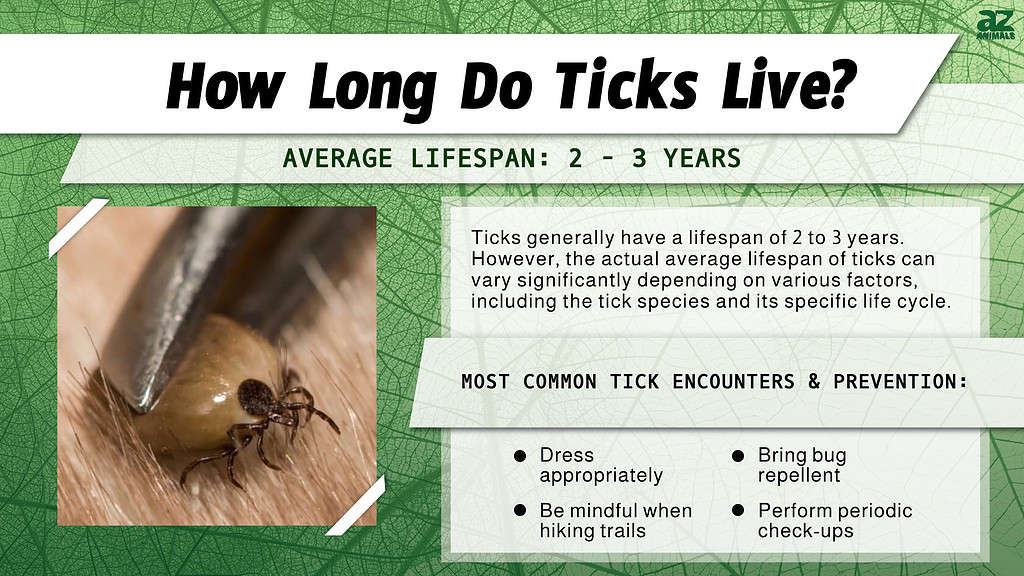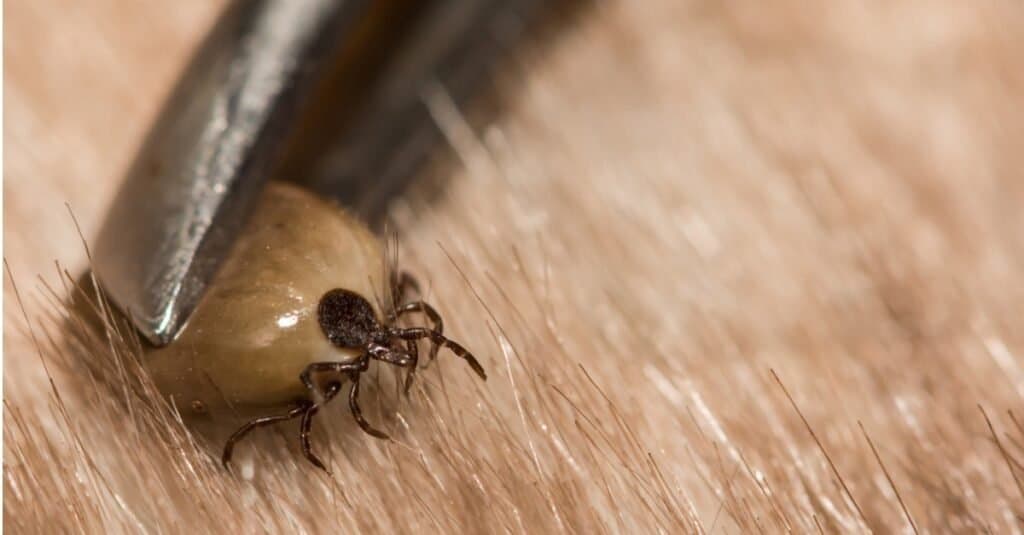
Do you happen to love exploring the outdoors? Whether it’s through hiking in the woods or exploring seaside grasses on the beach. There are many ways to enjoy the great outdoors. So if you’re a real outdoor enthusiast, then you must be familiar with the infamous pest known as ticks. Although small, these parasites are best known for spreading illnesses such as Lyme Disease and Rocky Mountain spotted fever.
If you’d like to learn tips on how to protect you, your family, and your friends from a bite from one of these parasites, then read on. We’ll explore the basics of ticks and learn to better understand the tick lifespan, life cycle, and all other sorts of cool facts!
The Rundown on Ticks

Ticks are more similar to spiders and scorpions than they are to insects.
©Afanasiev Andrii/Shutterstock.com
Although many assume that ticks happen to fall under the category of insects, you may be surprised to find out they are actually classified as parasitic arachnids! This means they are grouped in the same class as spiders, scorpions, and mites. All of them are listed within the class of Arthropods.
Ticks can be divided into two groups, soft and hard-bodied. Both are equally capable of spreading and transmitting diseases. “Hard ticks” have a shield located just behind their mouths, and when unfed tend to take on the resemblance of a small seed. “Soft ticks” on the other hand, do not carry this shield and take on the appearance of a raisin.
Now that we have a better understanding of which ticks are most commonly encountered by humans and animals, let’s delve into everything we need to know about the tick lifespan.
How Long Do Ticks Live?

Ticks can live for as long as 3 years.
©iStock.com/JasonOndreicka
The tick lifespan is between 2-3 years. However, the average tick lifespan truly depends on a number of factors, from the species of the tick to the very life cycle of the tick. However, according to the Ecology of Non-Nidicolous Ticks, “high saturation deficit, an index of humidity, can also shorten a tick’s lifespan.” This means that ticks are incredibly sensitive to their external environments.
Ticks go through several life stages before reaching maturity, and need to consume blood through each of those stages. Ticks can live anywhere from three to five months in between each life stage. Some may require multiple molts throughout that can take up to three years before achieving full adulthood.
A tick’s entire life purpose is to reproduce once they have reached adulthood. Male ticks usually die soon after mating, but female ticks can lay large quantities of eggs before they die.
The Average Tick Life Cycle
Now that we better understand the tick lifespan, let’s explore more about the interesting life cycle of a tick. This life cycle includes four stages: Egg, Larva, Nymph, and Adult.
Egg
After female ticks complete their 2-3 year life span, they often lay their batch of eggs in the spring. One female tick can lay more than a thousand eggs, either brown or red in color. One incredibly important thing to note is female ticks cannot lay eggs while attached to a host. This means that eggs can be found anywhere from leaves to other soft areas outside.
Larva
Once summer rolls around, tick eggs hatch into larva. Larvae require blood to mature. However, there are some species of larva that can survive for months without blood or without maturing at all. Once a larva finds a host to feed on, it will begin to mature. This involves shedding its skin and moving on to the next stage, the nymph.
Nymph
Once a nymph, unlike their larva stage, ticks now have 8 legs instead of 6. In order to reach full mature adulthood, nymphs must continue to find a blood host to consume. Depending on the nymph, some may become dormant, choosing to reach their final molt on the ground. Others choose to reach maturity while on the same blood host.
Adulthood
When a nymph reaches adulthood, it must take a second blood meal before it is able to reproduce. Both females and males participate in a blood meal before mating, and once having mated, the tick life cycle continues from the start again.
Most Common Tick Encounters & Prevention
There are many different outdoor activities that will have you running into ticks. Simple activities like gardening or exciting camping adventures can leave you vulnerable to a bite from a tick. Ticks are most active during the summer, but they can bite at any time of the year. Here are some steps to take to avoid coming across these blood-sucking parasites:
- Dress appropriately: Long sleeve shirts, pants, and sturdy boots prevent easy access from wandering ticks. It’s important to cover up any exposed areas of your body if you know you’re going to be exploring any area prone to ticks. Thick socks that reach past your ankles is another great way to avoid getting a tick on you.
- Bring bug repellent: When in nature, use an insect repellent that contains 10-30% DEET, permethrin, or picaridin. If you’re not into applying chemicals onto your skin, you can choose a more “natural” solution. Repellents with lemon eucalyptus oil will be your best bet.
- Be mindful when hiking trails: Always make sure you are walking in the center of trails, never brushing against grass or leaves. This will help prevent a tick from jumping onto you.
- Perform periodic check-ups: Continuously check yourself, your friends, and your family for any ticks whilst out. If your pets are accompanying you on hikes and trails always make sure to check on them as well to ensure a tick has not attached onto them.
The photo featured at the top of this post is © Afanasiev Andrii/Shutterstock.com
Thank you for reading! Have some feedback for us? Contact the AZ Animals editorial team.






